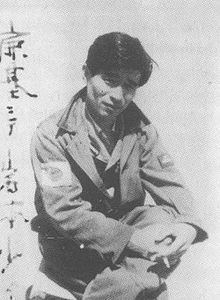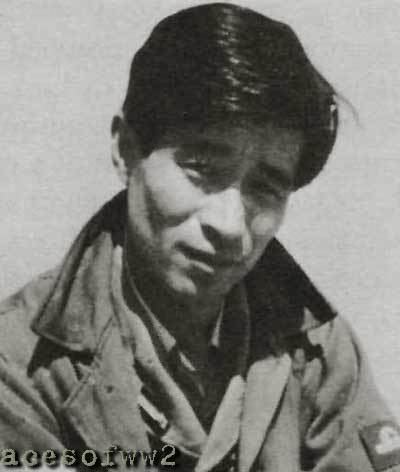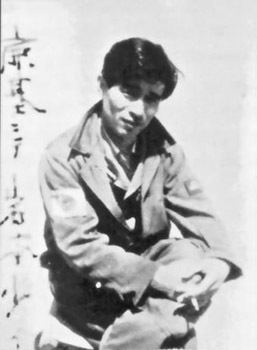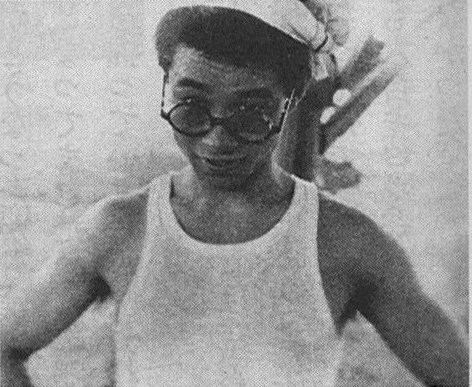Allegiance Japan Name Tetsuzo Iwamoto | Years of service 1934-1945 | |
 | ||
Nickname(s) Zero Fighter AceKotetsu "Tiger Tetsu" Rank Lieutenant Junior Grade Battles/wars Second Sino-Japanese WarWorld War II | ||
Battle of the coral sea tetsuzo iwamoto
Lieutenant Junior Grade Tetsuzō Iwamoto (岩本 徹三, Iwamoto Tetsuzō) was one of the top scoring aces among Imperial Japanese Navy Air Force (IJNAF) fighter pilots. He entered the Imperial Navy in 1934 and completed pilot training in December 1936. His first combat occurred over China in early 1938. He emerged as the top ace of the Imperial Japan during WWII, credited with at least 87 aerial victories including 14 victories in China. Subsequently he flew Zeros from the aircraft carrier Zuikaku from December 1941 to May 1942, including at the Battle of the Coral Sea.
Contents
- Battle of the coral sea tetsuzo iwamoto
- PC DOS Aces of the Pacific Ace vs Ace Dogfight against Tetsuzo Iwamoto
- Early life
- Starting military career
- China front
- His flight log
- His tactics
- Aerial victories claimed in his diary
- Promotions
- Awards
- Post war life
- Movie
- References

In late 1943, Iwamoto's air group was sent to Rabaul, New Britain, resulting in three months of air combat against Allied air raids.

Subsequent assignments were Truk Atoll in the Carolines and the Philippines, being commissioned an ensign in October 1944. Following the evacuation of the Philippines, Iwamoto served in home defense and trained kamikaze pilots.

Iwamoto was one of the highest-scoring Japanese aces. As a result of the Japanese use of the British naval practices, the IJNAF scoring system was based on the system the Royal Navy and the Royal Air Force (RAF) adopted from World War I until World War II. This system differed from the scoring system used by some other nations during World War II. Research by academics surnamed Izawa and Hata in 1971 estimated his score at about 80 or more than 87. In December 1993 Izawa wrote that Iwamoto was virtually the top ace of the IJNAF.

As of mid-1944, there remained only two IJNAF fighter pilots who were credited with over 100 victories. Depending on various totals cited, Tetsuzō Iwamoto or Hiroyoshi Nishizawa was Japan's top ace. Iwamoto was known as the Chūtai leader (Flying Company, squadron of 8 to 16 fighters). Iwamoto was one of few survivors of the IJNAF from the early part of the Second World War. He fought over the Indian and the Pacific Ocean from north to south, and trained young pilots even in the last months of the war. Like many Japanese veterans, Iwamoto was reported to have fallen into depression after the war. His diary was found after his death, with claims of 202 Allied aircraft destroyed.

[PC DOS] Aces of the Pacific - Ace vs. Ace - Dogfight against Tetsuzo Iwamoto
Early life

Tetsuzo was the third son of the Iwamoto family. He was born on a border town, southern part of Karafuto 15 June 1916, later grew up in Sapporo, Hokkaidō, Japan. He enjoyed skiing in his elementary school days. When he lived in Sapporo, his father was a chief police officer.

When he was 13, his father retired and Tetsuzo moved with his family to his father's hometown, Masuda, Shimane prefecture. He studied at the Prefectural Masuda Agricultural and Forestry High School. His favorite school subjects were mathematics and geometry; in these subjects, he always scored A's on his school report.

He was an active and nimble boy. He joined a school club brass band as a trumpeter. Another hobby was growing plants and flowers. He helped local fishermen in the fishing season, going out to the sandy beach early in the morning and driving fish into the nets. He talked down to his teachers sometimes in discussions, which was very impolite for a school student in pre-war Japan. He was regarded as the most opinionated student in his school.
Starting military career
Iwamoto started his military career in 1934 after he graduated the school at 18. Following the advice from his parents to study while young, Tetsuzo left for a large city where he was supposed to take a college entrance examination. He, however, secretly applied for and passed the examination for acceptance as an Imperial Japanese naval airman 4th class, and was promoted to 3rd class 5 months later. His parents were very disappointed, for they became reliant upon Tetsuzo rather than his eldest brother, who was already studying at some university in a large city and would not return to Masuda.
In 1936, when he was a naval mechanic 2nd class and a crewman on the light aircraft carrier Ryūjō, he studied hard and passed the difficult IJNAF exam, taken by thousands of applicants. He was enrolled in the class 34th Soju-Renshusei (Soren means flight trainee program) for naval petty officers and sailors. He graduated as one of the select 26 young aviators of the class 34th Soju-Renshusei (flight trainee program) in December of that year.
On April 4, 1936, he was sent to Kasumigaura-Ku (Kasumigaura FR(AG)) as a probationer in the class 34th Sojyu-Renshusei (flight trainee program), then on April 28, formally joined Kasumigaura-Ku. While his training going on November 1, 1936, he was promoted to naval mechanic 1st class. Finally on December 26, he graduated 34th class of Sojyu-Renshusei, was promoted to airman 1st class (old rank name of pre-war Japan, equivalent to senior airman). During flight training school at the Tomobe branch of Kasumigaura-Ku (Kasumigaura FR(AG)), his fighter course instructor was the well-known Chitoshi Isozaki.
In December 1936. Iwamoto entered Saeki Kōkūtai (a Kōkūtai was a Naval Air Group, whether being based at land or on board a carrier) for 6 months of advanced training (termed extended education), finished and next entered Omura Kōkūtai on July 16, 1937. He had hard training there every day from senior pilots including Air Petty Officer 1st class Toshio Kuroiwa (rank grade was at that time), who was the IJNAF legendary dogfight master pilot. Tetsuzo Iwamoto (called Tetsu in short from his senior pilots) had to wait for his debut until February 10, 1938.
China front
Tetsuzo's ability as a fighter pilot was recognized by all on his first air mission with the 13th Flying Group on February 25, 1938 over Nanchang, China.
After combat training, on February 10, 1938, Tetsuzo Iwamoto was led by his leader APO 1/C Toshio Kuroiwa, flying for two and a quarter hours over the China Sea from Omura Airbase at Kyūshū Japan to the airfield outside of Nanjing China.
His squadron on the Chinese frontline was the 13th Flying Group Fighter Squadron. This Flying Group was highly regarded and was famed as the Nango Fighter Squadron, named after its former squadron leader, Mochifumi Nango, who had showed considerable courage and conspicuous leadership.
Iwamoto's first combat came on February 25, 1938 over Nanchang. His squadron's fighters escorted bombers Type 96 land-based attack aircraft. Chinese's fighters attacked, and the squadron's leader Lieutenant Takuma was lost on this mission.
Iwamoto described his first combat in his notes. During the escort mission, his squadron was intercepted by sixteen I-15s and I-16s at an altitude of 5000 meters. Iwamoto claimed 4 victories (1 probable) in the combat. He secured his first victory by firing when within 50m of the enemy fighter. He first saw white smoke, then the enemy burned up and crashed. He was then at an altitude of 4000 m. When he looked back, there was an enemy fighter just behind him. He instantly made a Split S maneuver and narrowly escaped.
He got his second victory against an I-15. He saw it below him, turned and attacked from its 6 o'clock high. When it was hit, it climbed sharply and went spinning downward out of control and crashed into the ground. He kept his altitude of 4,000 m. He got an I-16 at the top of its roll in his gunsight and fired a burst, its engine burning and out of control; Tetsuzo lost sight of it before it crashed, and he reported this as probable. Another I-15 came down to him from 12 o'clock ahead. Both made a climb and were soon in a dogfight. The I-15 tried to break free of him and made a straight dive. That action made it easier for Tetsuzo to aim. He downed this I-15 on farmland near the airfield. He was flying at an altitude of 2000 m.
Above him, many enemy fighters were maneuvering. He found one of them coming down with landing gear down. He chased it to an altitude of 200 m and fired a burst. The I-16 was surprised and made a split S maneuver, but crashed at a corner of the airfield. This was his 4th victory.
Anti-aircraft guns started firing heavily, and he found himself in an intense barrage of flak. Rushing to escape at full throttle with a number of enemy fighters behind him, he succeeded in returning safely from the battlefield. His leader Kuroiwa had already returned to the Wuhu airfield, Anhui China, waiting for his return. Kuroiwa scolded Tetsu severely for the rash attacks he made on the day.
The 13th Flying Group Fighter Squadron was merged with the 12th Fighter Squadron on March 22, 1938, where Type 96 carrier fighters for 1st Chutai had landing gear painted in red and were called Red legs squadron while 2nd Chutai had gear painted in blue and were called Blue legs squadron.
Iwamoto was awarded the citation of flying group Cmdr Tsukahara for his extreme courage and conspicuous gallantry in action above and beyond the call of duty as a fighter pilot against intense Chinese air force on April 29, 1938. He made 82 sorties and 14 victories credited in the China front. Tetsuzo Iwamoto became the top IJNAF ace. His activities subsequently earned him Order of the Golden Kite - 5th class recommendation in 1940.
In September 1938, 22 years old Iwamoto was ordered back to Japan, where he became a member of the Saiki Air Group and appointed to a training staff.
His flight log
Flying Technique: Class-A of IJNAFFlight hours: over 8,000hrs on March 1944Oceanic Transition: possible, navigating and leading his fighter chutai (without Radar)Instrument Flight: possibleNight Flight: possibleOnly experienced fighter pilots in the IJNAF could execute instrument flight with their single-seat fighter aircraft on combat missions; few IJNAF officer pilots could fly on instruments.
His tactics
Single to single dogfight tactic - from losing to winning
Quick roll (Roll Sempoh)Coke-screw loop (Hineri-Komi Sempoh)Yo-yo turn (Suichoku-Senkai Kasoku Sempoh)Formation tactics -
Two groups linked formation attackKeeping his groups underneath thick clouds to hide his formation and waiting until the small number of opponent aircraft group coming down, then diving and zooming attack with all in formation.Attacking the opponent groups after their mission over and on the way to the waiting circle, in a group to fly back across the distance range over the sea. This tactics was taken when his group had much less number of aircraft.No.3 Areal Bomb attack tactic -
Twelve o'clock high vertical dive attack from the front top in inverted flight (Haimen Suichoku Kohka Sempoh)Aerial victories claimed in his diary
(World War II, 8 December 1941 - July 1942, April 1943 - 15 August 1945, Allied U.S. Army, Navy, Marine, Royal Navy, Australia, New Zealand)
Promotions
from the corresponding article in the Japanese Wikipedia
Awards
from the corresponding article in the Japanese Wikipedia
Post-war life
Allied Occupation Forces searched for war criminals in the Japanese Officer Corps. He was summoned twice to Douglas MacArthur's Allied GHQ office in Tokyo. Though he avoided being declared a war criminal, he was blacklisted for public sector employment. Managers of nongovernmental businesses and local factories in his hometown also did not dare to employ him, in order to comply with the wishes of the new Allied GHQ. Those who had been officers in the IJA or IJN were disliked by the Allied Occupation Forces.
Japanese journalists who had promoted Japanese militarism campaign during the war started a radio program of anti-militarism postwar called ""Shin-Jitsu wa Kou da (The Truth Is This)"". People like Iwamoto were considered the cat's-paws of militarism there.
Iwamoto struggled to survive until the San Francisco Peace Conference was held and the Allied Occupation Forces left Japan in the spring of 1952. In 1952, he finally obtained employment at the Masuda spinning mill of Daiwa Bouseki (now renamed as "Daiwabo" Co., Ltd, 大和紡績 ). However, in summer 1953, he developed a stomach ache. A surgeon examined him and diagnosed enteritis. It was found later to be appendicitis.
After a series of operations, he complained of a backache. Doctors decided to operate on him again. With cause unknown, they removed three or four ribs without anesthesia. This led to sepsis (septicemia, blood poisoning).
His wife recalled his words, "When I get well, I want to fly again." He died on 20 May 1955.
